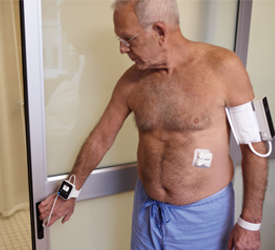Experts are excited about the swift development of wireless remote monitoring of patients; companies expected to develop sensors that incorporate a wide range of biomarkers
Some experts predict that the era of wireless, remote monitoring of patients is almost upon us. It will require pathologists and medical laboratory professionals to learn a new acronym: MBAN, which stands for medical body area network.
There is keen interest in remote wireless monitoring systems. The concept is to free patients from the hospital bed and allow continuous remote monitoring, regardless of where the patient is located. For this reason, in just a few years and in many local markets, opportunities are likely to be ripe for pathologists and clinical laboratory teams to have a role in managing wireless medical devices that use MBANs.
Rapid Advances in the New Field of Medical Body Area Networks
MBANs support small wearable, wireless sensors that capture patient vital signs (temperature, respiratory function, and more) and could help extend care anywhere throughout the hospital or even remotely in the home, according to a joint statement by GE Healthcare (NYSE: GE) and Royal Philips Electronics (NYSE: PHG), two companies that have created sensor technologies.
Action taken by the Federal Communications Commission (FTC) during 2012 is one big reason why corporations are more actively developing systems and products that use an MBAN. The FTC released new rules and a report in May 2012.
The FCC has allocated specific, protective communication spectrum for MBANs that blocks transmissions from Wi-Fi and other high-powered consumer devices. Typically, an MBAN device involves monitors worn by patients that send non-voice data to nearby hubs. The FCC allocated 40 MHz of spectrum in the 2360-2400 MHz band for MBANs. The 2360-2390 MHz band will be used only indoors. The 2390-2400 MHz band is for outdoor use.
FDA Says MBANs Will Be Better Than Traditional Monitoring Devices
“The MBAN concept would allow medical professionals to place multiple inexpensive wireless sensors at different locations on or around a patient’s body and to aggregate data from the sensors for backhaul to a monitoring station using a variety of communications media. We conclude that an MBAN represents an improvement over traditional medical monitoring devices (both wired and wireless) in several ways, and will reduce the cost, risk and complexity associated with healthcare,” according to the FCC report.
“For example, a healthcare facility could monitor more patients, particularly in patient care areas where WMTS is not currently installed; an MBAN could be used outside the healthcare facility, e.g. within patients’ homes; and an MBAN could be used for both monitoring and therapeutic applications,” the FCC said.
HealthCare Experts Foresee Cost Savings from Remote Monitoring
Currently, patients are usually monitored in acute and pricey intensive care departments. The sensors they wear are hard-wired to monitoring systems. Conversely, the MBANS are low-cost wearable sensors that allow clinicians to view vital signs wherever patients are located.
“Normally, in a hospital, patients are only getting checked once a shift,” stated Eric Topol, M.D., Director of the Scripps Translational Science Institute in San Diego. “To have continuous monitoring—which is why a lot of people are in the intensive-care unit—that’s a big plus. That could lead to lower costs and less utilization of the intensive-care unit facility. Ultimately, the bigger opportunity is just getting people out of the hospital and then doing remote monitoring,” said Topol in a story published by Modern Healthcare.
Developers of remote monitoring systems agree that efficiencies in healthcare are possible and added that the benefits may come sooner, rather than later, in light of the FTC’s action to dedicate spectrum specifically for MBANs.
Industry Development of Wireless Monitoring Systems to Go into ‘Overdrive’
“With access to special-purpose spectrum, the healthcare industry’s research and development efforts can go into overdrive,” declared Anthony Jones, Chief Marketing Officer for Patient Care and Clinical Informatics at Philips Healthcare, in a press release issued by his company. “The expansion of wireless monitoring capabilities will help allow earlier clinical diagnoses, decisions and interventions, supporting the delivery of better patient care at lower costs,” he added.

Philips Healthcare recently received clearance from the FDA for the cableless respiration sensor worn on the wrist of this patient. The device wirelessly transmits data and operates on a communication spectrum devoted to the medical body area network. (Photo copyright Royal Philips Electronics)
A research report issued by ABI Research predicted that about five million MBAN sensors will be available in the marketplace by 2018. This is likely to happen mostly in the United States because it is the only country to have communication spectrum devoted to MBANs.
Wireless monitoring systems could turn out to be a game changer for clinical diagnostics if developers can develop sensors that read multiple biomarkers in real time and can produce information that supports early detection of disease and continuous monitoring of a patient. Pathologists and clinical laboratory managers should not underestimate the speed with which biotech companies and research teams can develop miniaturized systems that deliver accurate diagnostic information in real time via the MBAN.
—By Donna Marie Pocius
Related information:
Federal Communications Commission Medical Body Area Networks First Report
Disposable wireless sensor market shows signs of life-shipments to reach five million in 2018
Nearly 5 million disposable, wireless MBAN sensors to ship by 2018



